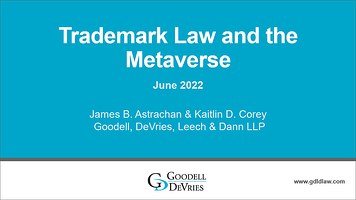Jim Astrachan presented “Trademark Law and the Metaverse” at the Maryland State Bar Association’s Annual Meeting in June 2022. Jim’s slides are available here.


Jim Astrachan presented “Trademark Law and the Metaverse” at the Maryland State Bar Association’s Annual Meeting in June 2022. Jim’s slides are available here.

One of the British tabloids has taken Meghan Markle to task because she wants to trademark “archetypes” for use in conjunction with her Spotify podcast. The tabloid defiantly asserts archetypes is 470 years old. So? They write she should not be entitled to own this word. She is, however, entitled to grab a word from the dictionary and use it as a trademark to the exclusion, in category, of anyone else’s use.
On May 20, 2019, the Supreme Court answered the longstanding question of what happens to a licensee’s right to use a trademark under a license agreement if a bankrupt licensor rejects the license agreement. The Court held that a licensor’s ability to reject a license agreement does not extinguish licensee’s rights under the trademark license and therefore, the licensee may continue to use the trademark under the terms of the license agreement. Continue reading
In August of last year, I wrote a blog post analyzing the likelihood of confusion factors as applied to the trademark infringement claim that PayPal filed against Pandora based on Pandora’s blue “P” logo.

In November the parties reached a settlement agreement and PayPal dismissed the lawsuit against Pandora. No details of the settlement were announced.
Recently I noticed what I thought was a new app on my iPhone; but it wasn’t a new app — it was Pandora’s app with a new logo design. If you have the Pandora music app on your smart phone, you also may have noticed that Pandora’s logo is quite different than it was before (I like it).

I can only speculate as to what the settlement agreement between Pandora and PayPal says, as it is likely confidential, but it is common in settlement agreements concerning trademark disputes that the alleged infringer is given a certain amount of time to phase out an infringing mark and rebrand. Perhaps that is what happened here.
By now just about everyone is aware that the UMBC Retrievers became the first Number 16 seed to beat a Number 1 seed in the NCAA men’s basketball tournament. Prior to this past Friday night, many may not have been aware of the existence of UMBC, and now everyone is talking about this historical win.
With the massive amounts of attention that the school is getting, the school’s officials were made aware that UMBC did not have a trademark registration for “Retrievers.” Continue reading
Sellers of goods often will add a design element to their product and claim no competitor can copy its design, asserting it will violate trademark rights because the design element has become associated with the seller in the minds of consumers. In other words, the design element functions as a trademark. Take, for example, the solid red sole of the Christian Louboutin shoe.
Recently, LVL XIII, a seller of popular sneakers featuring a rectangular metal plate design on the toe, sued Louis Vuitton for using a similar metal toe plate design on its shoes. Continue reading
Trademark infringement is not unheard of to Under Armour – although Under Armour is usually the one claiming infringement. The popular athletic company has brought several trademark infringement suits, including recent lawsuits against Puppy Armour, Inner Armour, Salt Armour and Ass Armour.
However, the tables recently turned when Under Armour filed a declaratory judgment action that it was not infringing. A declaratory judgment action is filed to clarify the legal rights of parties.
In an ongoing trademark dispute between Forever 21 and Gucci, Forever 21, Inc. v. Gucci America, Inc., et al., 2:17-cv-04706 (C.D. Cal.), Gucci recently got the upper hand, slightly: the court granted Gucci’s partial motion to dismiss–but permitted Forever 21 to amend its complaint.
This dispute began nearly a year ago, in December 2016, when Gucci sent Forever 21 a cease and desist letter demanding that Forever 21 cease all sales of garments and accessories bearing the stripe combination blue-red-blue. Gucci owns a federal trademark registration for that stripe combination.